Alesis MICRON User Manual

micron
Reference Manual
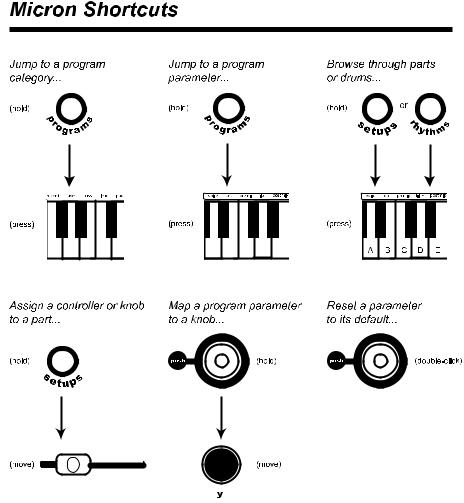

|
Table Of Contents |
|
Introduction ............................................................................................ |
5 |
|
Welcome! ....................................................................................................................................................................... |
5 |
|
Unpacking and Inspection................................................................................................ |
6 |
|
How to Use This Manual.................................................................................................... |
6 |
|
Connection Diagram ................................................................................................................................................... |
7 |
|
Connecting AC Power ................................................................................................................................................ |
7 |
|
Making Audio Connections........................................................................................................................................ |
7 |
|
Connecting the Foot Pedals ....................................................................................................................................... |
7 |
|
Chapter 2: First Session ....................................................................... |
9 |
|
A Tour of the Micron .......................................................................................................... |
9 |
|
The Micron’s top panel ...................................................................................................... |
9 |
|
Volume........................................................................................................................................................................... |
9 |
|
Real-time controllers.................................................................................................................................................... |
9 |
|
Performance buttons ................................................................................................................................................... |
10 |
|
Display ........................................................................................................................................................................... |
10 |
|
Control knob circle ...................................................................................................................................................... |
10 |
|
Key concepts......................................................................................................................... |
10 |
|
Programs........................................................................................................................................................................ |
10 |
|
Rhythms......................................................................................................................................................................... |
10 |
|
Patterns .......................................................................................................................................................................... |
10 |
|
Setups ............................................................................................................................................................................. |
10 |
|
Navigating with the transparent control knob and its buttons ............................................................................ |
11 |
|
Play the Programs .............................................................................................................. |
12 |
|
Navigate through the programs................................................................................................................................. |
12 |
|
Switch Octaves .................................................................................................................... |
13 |
|
Explore the Built-in Patterns........................................................................................... |
14 |
|
Explore the Rhythms.......................................................................................................... |
15 |
|
Explore the Setups.............................................................................................................. |
16 |
|
Record Some Phrases......................................................................................................... |
17 |
|
Connect External Instruments ........................................................................................ |
18 |
|
Whew!..................................................................................................................................... |
18 |
|
Chapter 3: Patterns................................................................................ |
19 |
|
Playing Patterns.................................................................................................................. |
19 |
|
Using [latch] .................................................................................................................................................................. |
19 |
|
Using [tap] ..................................................................................................................................................................... |
19 |
|
Pattern Types: Arpeggios and Sequences .................................................................... |
20 |
|
Editing Patterns .................................................................................................................. |
21 |
|
1. |
Revert-to-stored? / Unrevert-to-edited?............................................................................................................. |
21 |
2. Send to setup?........................................................................................................................................................... |
22 |
|
3. Start new setup? ....................................................................................................................................................... |
23 |
|
4. Pattern program ....................................................................................................................................................... |
23 |
|
5. |
Length....................................................................................................................................................................... |
23 |
6. |
Grid........................................................................................................................................................................... |
24 |
7. |
Type .......................................................................................................................................................................... |
24 |
8. |
Span (arpeggios only) ............................................................................................................................................. |
24 |
9. |
Order (arpeggios only) ........................................................................................................................................... |
24 |
10. |
Real-time recording .............................................................................................................................................. |
25 |
11. |
Step editing ............................................................................................................................................................ |
26 |
12. |
Clear controllers? .................................................................................................................................................. |
27 |
13. |
Clear pattern? ........................................................................................................................................................ |
27 |
14. |
Pattern name ......................................................................................................................................................... |
28 |
1

|
|
|
Table Of Contents |
15. Send MIDI sysex?................................................................................................................................................. |
28 |
||
16. |
Send syx bundle?................................................................................................................................................... |
28 |
|
17. |
Delete pattern? ...................................................................................................................................................... |
28 |
|
18. |
Store a copy?.......................................................................................................................................................... |
29 |
|
Store your changes!...................................................................................................................................................... |
29 |
||
Exiting pattern editing................................................................................................................................................. |
29 |
||
Chapter 4: Rhythms............................................................................... |
31 |
||
Playing Rhythms................................................................................................................. |
31 |
||
Using [tap] ..................................................................................................................................................................... |
31 |
||
Editing Rhythms ................................................................................................................. |
32 |
||
1. |
|
Revert-to-stored? / Unrevert-to-edited?............................................................................................................. |
32 |
2. |
Send to setup?........................................................................................................................................................... |
33 |
|
3. |
Start new setup? ....................................................................................................................................................... |
34 |
|
4. |
|
Length....................................................................................................................................................................... |
34 |
5. |
|
Grid........................................................................................................................................................................... |
34 |
6. |
|
Record rhythm (real-time)..................................................................................................................................... |
35 |
7. |
|
Drum A through Drum H .................................................................................................................................... |
36 |
8. |
|
Add?.......................................................................................................................................................................... |
38 |
9. |
|
Clear rhythm? .......................................................................................................................................................... |
39 |
10. Rhythm name ......................................................................................................................................................... |
39 |
||
11. Send MIDI sysex?................................................................................................................................................. |
39 |
||
12. |
Send syx bundle?................................................................................................................................................... |
39 |
|
13. |
Delete rhythm?...................................................................................................................................................... |
40 |
|
14. |
Store a copy?.......................................................................................................................................................... |
40 |
|
Store your changes!...................................................................................................................................................... |
40 |
||
Exiting rhythm editing ................................................................................................................................................ |
40 |
||
Chapter 5: Setups ................................................................................... |
41 |
||
Playing Setups ..................................................................................................................... |
41 |
||
Setup Components.............................................................................................................. |
41 |
||
Editing Setups...................................................................................................................... |
41 |
||
1. |
|
Parts .......................................................................................................................................................................... |
44 |
2. |
|
Use as........................................................................................................................................................................ |
48 |
3. |
|
Add?.......................................................................................................................................................................... |
48 |
4. |
|
Beats.......................................................................................................................................................................... |
49 |
5. |
|
Add?.......................................................................................................................................................................... |
51 |
6. |
|
FX Type ................................................................................................................................................................... |
52 |
7. |
|
Clear .......................................................................................................................................................................... |
52 |
8. |
|
Setup name .............................................................................................................................................................. |
52 |
9. |
|
Send MIDI sysex?................................................................................................................................................... |
53 |
10. |
Send syx bundle?................................................................................................................................................... |
53 |
|
11. |
Delete setup? ......................................................................................................................................................... |
53 |
|
12. |
Store a copy?.......................................................................................................................................................... |
53 |
|
Store your changes!...................................................................................................................................................... |
53 |
||
Store your changes!...................................................................................................................................................... |
54 |
||
Exiting setup editing.................................................................................................................................................... |
54 |
||
Chapter 6: Programs ............................................................................. |
55 |
||
What is a “Program”? ......................................................................................................... |
55 |
||
Chapter 5: Program Parameters ........................................................ |
55 |
||
How the Micron Makes Sound ......................................................................................... |
55 |
||
The Oscillators ............................................................................................................................................................. |
55 |
||
The Pre Filter Mix........................................................................................................................................................ |
56 |
||
2

Table of Contents
The Filters ..................................................................................................................................................................... |
56 |
||
The Post Filter Mix...................................................................................................................................................... |
56 |
||
Output............................................................................................................................................................................ |
57 |
||
Signal Flow Diagram ................................................................................................................................................... |
57 |
||
Modulation............................................................................................................................ |
58 |
||
The LFOs ...................................................................................................................................................................... |
58 |
||
The Envelopes.............................................................................................................................................................. |
59 |
||
Playing Programs ............................................................................................................... |
60 |
||
Editing Programs................................................................................................................ |
60 |
||
1. |
|
Revert-to-Stored? / Unrevert-to-Edited?........................................................................................................... |
60 |
2. |
Add to Faves? / Remove Fave? ........................................................................................................................... |
60 |
|
3. |
Send to Setup? .......................................................................................................................................................... |
61 |
|
4. |
Start New Setup?...................................................................................................................................................... |
62 |
|
5. |
|
Voice parameters .................................................................................................................................................... |
63 |
6. |
|
Oscillator parameters ............................................................................................................................................. |
67 |
7. |
|
Pre-filter mix parameters....................................................................................................................................... |
68 |
8. |
|
Filter parameters ..................................................................................................................................................... |
69 |
9. |
|
Post-filter mix parameters ..................................................................................................................................... |
70 |
10. |
Output .................................................................................................................................................................... |
71 |
|
11. |
Envelopes .............................................................................................................................................................. |
72 |
|
12. |
Low Frequency Oscillator (LFO) settings........................................................................................................ |
75 |
|
13. |
Sample-and-Hold (S&H) settings ...................................................................................................................... |
77 |
|
14. |
Track (Tracking Generator)................................................................................................................................ |
78 |
|
15. |
Mod (Modulation Routing)................................................................................................................................. |
79 |
|
16. |
Category ................................................................................................................................................................. |
83 |
|
17. |
Program name....................................................................................................................................................... |
83 |
|
18. |
Delete?.................................................................................................................................................................... |
84 |
|
19. |
Send MIDI sysex?................................................................................................................................................. |
84 |
|
20. |
Store a copy?.......................................................................................................................................................... |
84 |
|
Store your changes!...................................................................................................................................................... |
84 |
||
Exiting program editing .............................................................................................................................................. |
85 |
||
Chapter 7: Configuration ..................................................................... |
87 |
|
Configuration....................................................................................................................... |
87 |
|
Configuration Parameters................................................................................................ |
87 |
|
1. |
Contrast.................................................................................................................................................................... |
87 |
2. |
Tuning ...................................................................................................................................................................... |
87 |
3. |
Transpose................................................................................................................................................................. |
87 |
4. |
Velocity Curve......................................................................................................................................................... |
88 |
5. |
Local Control........................................................................................................................................................... |
89 |
6. |
MIDI mode ............................................................................................................................................................. |
90 |
7. |
MIDI channel.......................................................................................................................................................... |
90 |
8. |
MIDI sync................................................................................................................................................................ |
91 |
9. |
Sysex: send all......................................................................................................................................................... |
91 |
Chapter 8: MIDI ...................................................................................... |
93 |
What is MIDI?....................................................................................................................... |
93 |
MIDI Connections ...................................................................................................................................................... |
93 |
Saving Programs, Setups, Rhythms, and Patterns via MIDI System |
|
Exclusive........................................................................................................................................................................ |
95 |
Loading Programs, Rhythms, Patterns, and Setups via MIDI ............................................................................. |
96 |
What's a bundle?........................................................................................................................................................... |
96 |
Compatibility with Alesis Ion programs................................................................................................................... |
97 |
Sharing programs between the Alesis Micron and the Alesis Ion ....................................................................... |
97 |
Updating Software Via MIDI .................................................................................................................................... |
97 |
All Notes Off................................................................................................................................................................ |
98 |
3

|
Table Of Contents |
MIDI Implementation Chart ..................................................................................................................................... |
99 |
Appendix A: Frequently Asked Questions ....................................... |
101 |
How do I split/layer the keyboard? .......................................................................................................................... |
101 |
What is a MIDI Sequence? ......................................................................................................................................... |
101 |
Where can I get more Programs? .............................................................................................................................. |
101 |
Are Micron programs compatible with Ion programs?......................................................................................... |
101 |
Appendix B: Troubleshooting ............................................................. |
103 |
Recovering from a Crash ............................................................................................................................................ |
104 |
Checking the Software Version ................................................................................................................................. |
104 |
Cleaning Your Micron................................................................................................................................................. |
104 |
Specifications.......................................................................................... |
109 |
Sound Engine ............................................................................................................................................................... |
109 |
Audio Input................................................................................................................................................................... |
109 |
Audio Output ............................................................................................................................................................... |
109 |
Audio Performance...................................................................................................................................................... |
109 |
Physical .......................................................................................................................................................................... |
109 |
Warranty/Contact Alesis....................................................................... |
111 |
Alesis Limited Warranty.............................................................................................................................................. |
111 |
Alesis Contact Information ........................................................................................................................................ |
112 |
4

Introduction
Welcome!
Congratulations on your purchase of the Alesis Micron! The Micron is a powerful, 8-voice Analog Modeling synthesizer based on the award-winning sound engine of the larger Alesis Ion.
The Micron has every bit of sound-producing DSP horsepower contained in the Ion along with a few tricks of its own. The Micron’s front-panel interface is streamlined to give you full access to its Analog Modeling power while meeting the demanding requirements of real-time performance. Not only synth patches but melodic patterns and drum beats also are available to you in most cases simply by pressing a button and turning a knob. You can create sophisticated rhythms combining up to ten different sounds. You can create really rich setups combining as many as 26 different programs with anywhere from 0 to 26 different rhythms, all simultaneously active.
This is an exciting time for analog-style synthesizers. After a period of relative neglect brought on by the appearance of sampleplayback digital synths (which excel at realistic mimicry of various sound sources), the unique sounds of analog-style synths have been rediscovered. Analog Modeled basses dominate certain styles of music, and other analog-type elements – from drums to leads to pads – are frequently heard in contemporary popular music.
Alesis has been at the center of this resurgence. Our first product in the line was our A6 Andromeda, a true analog synth considered by many to be the most powerful non-modular analog synthesizer ever made. Next came the Alesis Ion, praised as one of the most powerful and best sounding Analog Modeling synthesizers ever.
Now, the Micron furthers this legacy, taking the Analog Modeled synthesizer in yet another new direction.
Please be sure to register your Micron at the Alesis website, www.alesis.com. And since the Micron’s operating system is upgradeable via MIDI, try to check the site once in a while for updates and extra goodies.
We hope and trust that you’ll find the Micron to be an inspiring instrument that you can turn to again and again for new ideas, new sounds, and new inspiration.
Sincerely,
The people of Alesis
For more effective service and product update notices, please register your Micron online at:
http://www.alesis.com
/support/warranty.htm
5

Introduction
Unpacking and Inspection
The shipping carton for your Micron should contain the following items:
●Micron synthesizer
●AC power adapter
●This instruction manual
●A warranty card
Please log on to the Alesis website at www.alesis.com to register your new Micron synthesizer. This will help us give you the best support we possibly can.
How to Use This Manual
We’re sure you’d like to jump in and start using your Micron quickly. To help you do this, refer to Chapter 1 for hook-up instructions, and then read Chapter 2 – “First Session.” This will get you playing in no time. If you have any questions, refer to the Frequently Asked Questions in Appendix A on page 101.
Chapters 3 through 6 cover the main operating modes of the Micron – the patterns, rhtyhms, setups, and programs.
For information on using the Micron along with other MIDI devices, refer to Chapter 8 “MIDI.”
Near the end of the manual are troubleshooting tips and specifications.
The names for all buttons, knobs, and wheels on the Micron are formatted throughout the manual so as to be easily identified. Here are some examples:
[setups] |
The top panel buttons are bolded and |
|
[bracketed]. |
(m1) |
Wheels, knobs, sliders, and rear-panel jacks |
|
are bolded and placed in (parentheses). |
Parameters |
Editable parameters are bolded. |
length |
Specific settings for various parameters are |
|
italicized. |
6
Helpful tips and advice are highlighted in a shaded box like this.
When something important appears in the manual, an exclamation mark (like the one shown at left) will appear with some explanatory text.
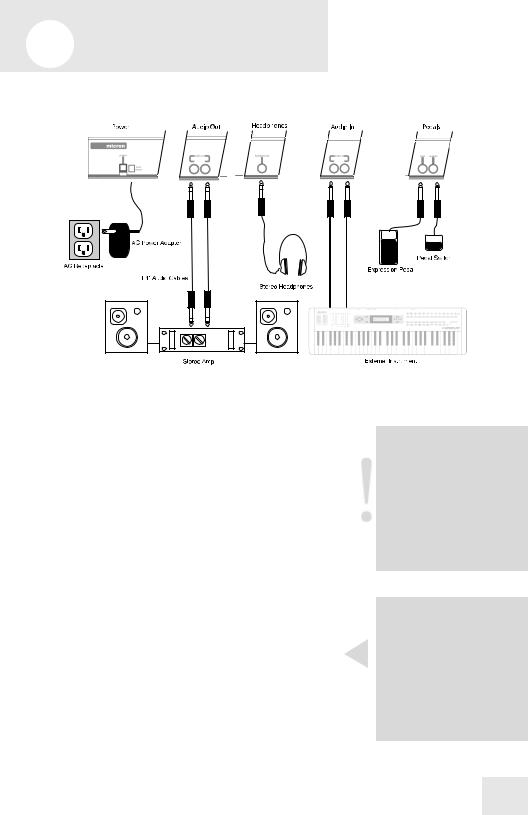
1 Connections
Connection Diagram
Connecting AC Power
Before making any power connections, make sure the Micron’s power switch is turned off. Then plug the adapter into the Micron and into a wall outlet.
Making Audio Connections
•Stereo outputs. Connect two cables from the Micron’s left and right outputs to two inputs of an amp or mixer.
•Headphones. Plug a set of headphones into the headphone jack on the rear panel.
Connecting the Foot Pedals
The Micron has two pedal jacks marked (sustain) and (expr). Plug a sustain pedal (not included) into the jack marked (sustain).
(sustain) is designed to work with any standard momentary footswitch. It doesn’t matter whether the footswitch is normally open or closed, as long as you plug it in before powering up your Micron; the instrument will calibrate itself.
(expr) is designed to work with a Roland EV-5 pedal or equivalent.
WARNING: When connecting audio cables or turning power on and off, make sure that the amplifiers in your system are turned off or the volume controls are turned down. If you don’t do this, you can create loud bursts of sound that might damage your speakers.
NOTE: If your sustain pedal response is backward (i.e., notes sustain when your foot is off the pedal), turn off your Micron and make sure the footswitch plug is fully inserted into the (sustain) jack. Then, turn the Micron back on while keeping your foot off the footswitch.
7

1 Connections
This page intentionally left blank.
8

2 First Session
A Tour of the Micron
In this session, we’ll:
●Explore the Micron’s top panel
●Define some key concepts.
●Play some of the Micron’s basic sounds (called programs).
●Learn different ways to navigate the Micron’s programs.
●Explore the built-in patterns.
●Capture and play back some phrases.
●Explore the Micron’s drum sounds and play some rhythms.
●Explore the Micron’s setups. Setups are where programs, patterns, rhythms, and more all come together in powerful, flexible combinations.
The Micron’s top panel
Volume
The (volume) knob on the far left-hand side of the Micron raises and lowers the volume. If you don’t hear anything as you play the Micron,
suspect the (volume) knob’s setting.
Real-time controllers
The (m1) and (m2) sliders, (pitch) wheel, and (x/y/z knobs), located on the left half of the Micron, provide real-time control of the Micron’s sounds.
9

2 |
First Session |
Performance buttons
The buttons in this cluster switch octaves, set the tempo, and perform other performance-related functions.
Display
Information relevant to the current operation is shown here.
Control knob circle
These are the Micron’s most important controls – the control knob and the buttons that surround it. Pressing one of these buttons – [programs], [setups], [config], [patterns], or
[rhythms] – puts you into one of the Micron’s primary modes of operation. Turning the control knob then cycles through options. Pressing the control knob allows for editing.
Key concepts
Here are the Micron’s most important concepts:
Programs
Programs are the Micron’s sounds, built from its oscillators, envelopes, filters, modulation matrix, and other analog-style components.
Rhythms
Rhythms are combinations of drum programs with patterns. Think of a drum machine with its interchangeable sounds and patterns. That’s pretty close to what rhythms are.
Patterns
Patterns are repeating melodic and/or rhythmic motifs. Arpeggios and step sequences are examples of patterns.
Setups
Setups combine multiple programs, rhythms, patterns, and more. They are the Micron’s most powerful and most sonically sophisticated element.
10

2 First Session
Navigating with the transparent control knob and its buttons
Use the transparent control knob to the right of the display and its surrounding circle of buttons to navigate through the Micron’s options. Most Micron functions involve pressing the buttons and then turning or pushing this knob.
“Green Light/Red Light”
The buttons circling the control knob glow green when selected and glow red when the control knob has been pushed (entering edit mode).
The exception is the [config] button. [config] only glows red, since it only performs editing functions.
At any one time, only one of the buttons will glow, indicating that the Micron is operating within that mode.
“Turn”
Turn the control knob to cycle through various options.
“Push”
Push the control knob to edit the option displayed. Push again to stop editing. See the following visual illustration:
11

2 |
First Session |
Play the Programs
The Micron’s basic sounds are called “Programs.” Play some of these programs now.
Find the [programs] button on the right side of the top panel. Press it; then spin the control knob. Notice how the programs are organized by category – first basses, then leads, then pads, etc.
Turn the volume up and listen to some of these programs. Experiment with the (pitch) wheel, the (x/y/z knobs), and the two sliders. Here are a few points to note:
●The (pitch) wheel glows progressively brighter as you turn it..
●The (x/y/z knobs) do different things depending on the Program. Sometimes, they increase or decrease the quickness of the attack. Sometimes, they change the tone by adjusting the filter resonance. Each time you change Programs, the X/Y/Z knobs reset to their original positions.
●The (m1) slider typically – but not always – adds vibrato.
●The (m2) slider typically – but not always – sweeps the filter frequency, radically changing the tone.
Play some notes before, during, and after moving the (m2) slider. You’ll most likely hear the classic analog synthesizer “filter sweep” sound.
Navigate through the programs
Rotate the control knob enough, and you’ll pass through 13 categories of programs. At the end of the list, all of the programs are presented alphabetically, regardless of category.
Using the [programs] + white key shortcut
Notice the red text just above the keyboard. This text corresponds to the 13 categories and also includes the all, uncategorized listing. To access a category instantly, hold down [programs] and then press the associated white key.
12

2 First Session
Special categories
All
As we’ve already seen, the all category is an alphabetical listing of all the Programs.
Recent
The Programs you’ve played recently are stored for you automatically under the Recent category. They are still listed under their primary categories. This is a duplicate listing to allow for super-fast access. Note that you cannot directly edit this listing. You need to select and then play the Programs you want to be listed here.
Faves
● Adding Programs to Faves
When you find a Program you particularly like, add it to the Faves (“Favorites”) category. In [programs] mode, press the control knob to enter edit mode. You will be prompted to Add to faves? Press the control knob once again to add the Program to the Faves category.
Press the [programs] button again if you want to cancel this action and exit the editing screens.
● Removing Programs from Faves
To remove a Program from the Favorites list, call up the program and press the control knob. You will be asked, Remove fave? Press the control knob to perform the action.
Switch Octaves
While the Micron is a compact unit, all of its sounds span the full 128-note MIDI range. Use the [octave] buttons to the left of the display to transpose the keyboard up and down to cover that range.
Notice how one or the other [octave] lights glows progressively brighter as you push it. This provides a visual indication of the current octave setting.
Press both [octave] buttons simultaneously to return to the default octave setting.
13

2 |
First Session |
Explore the Built-in Patterns
The Micron features a powerful pattern sequencer with lots of editing capabilities. We’ll discuss the editing features later. For now, let’s get our feet wet playing some patterns.
Press the [patterns] button to the left of the display.
Turn the control knob to cycle through various preset patterns. Play the keyboard to hear them.
[tap]
Tap the [tap] button to the left of the display. Watch and hear how [tap] controls the tempo. Note that the pattern’s tempo immediately locks to the speed at which you tap.
To adjust the tempo with finer control (one-tenth of a beat per minute), hold down the [tap] button and turn the control knob left or right to slow down or speed up. The display will indicate the current tempo.
[latch]
Press the [latch] button, also to the left of the display. Remove your hands from the keyboard. The pattern keeps playing.
Press [latch] again to stop the pattern from playing.
14
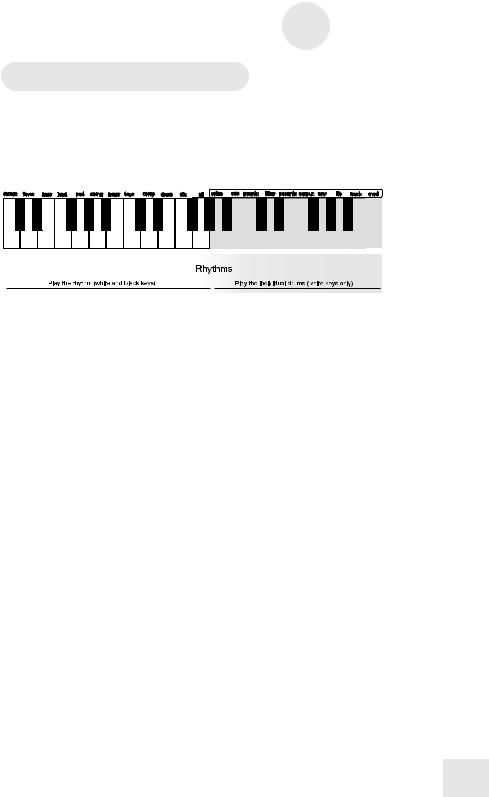
2 First Session
Explore the Rhythms
Rhythms combine drum/percussion programs with specifically designed rhythm patterns.
Press [rhythms]. Turn the control knob to cycle through different rhythms.
● To play a rhythm
Press and hold any key from the bottom of the keyboard up to the middle G#. (These are the keys labeled from recent through all.)
● To play a rhythm’s individual drum sound
Press one of the white keys from middle A (labeled voice) upward.
The keyboard’s middle A corresponds to the rhythm’s Drum A. The next higher note, B (labeled osc), corresponds to Drum B. Proceeding higher, drums C, D, E, etc. are triggered. Any keys higher than the rhythm’s highest note will do nothing.
● To play a rhythm hands free
Press any key from middle G# down on the keyboard. While holding down that key, press [latch] to keep the rhythm going. Press [latch] a second time to stop the rhythm.
● To change the tempo
Tap the [tap] button a few times, or hold down [tap] and turn the control knob.
● To change to a different rhythm
Turn the control knob to change the rhythm. The newly selected rhythm will begin to play once the last rhythm reaches the end of its cycle. (To make the newly selected rhythm begin playing immediately, press any key from all downward.).
15

2 |
First Session |
Each rhythm’s sounds, relative sound levels, left/right panning, rhythmic patterns, time signature, duration, quantization, and name can be edited. (We’ll leave the editing for a later chapter.)
Explore the Setups
Press [setups] to explore this mode – the most sophisticated mode of the Micron.
Setups combine the following elements:
●Multiple Programs.
●Multiple Patterns.
●Multiple Rhythms.
●Splits (like placing a rhythm on the left side of the keyboard, a bass program in the middle, and a lead program up top).
●Latch on/off settings.
●Semitone transpositions.
●Level and left/right panning.
●Effects settings.
●Controller assignments.
Once you’ve mastered setups, you’ve mastered the Micron! In this first session though, simply press the [setups] button, twirl the control knob a few times, and listen to the various presets. Be sure to play throughout the keyboard range to experience the various splits, layers, and rhythm triggers. These presets will give you a good sense for some of the different possibilities you can create on your own.
16

2 First Session
Record Some Phrases
You don't have to be in Patterns mode to create a pattern. At any time, the Micron can capture your playing and use it as a pattern.
Press [programs] to enter Programs mode. Hold down the [phrase] button and start playing a riff. As soon as you hit the first note, the [phrase] button will start flashing, indicating that it is recording what you play. You can release the [phrase] button any time after you’ve played that first note.
When you are done playing the phrase, press the [phrase] button again. The button will light, indicating that the Micron is ready to play your phrase back. Press any key, and you’ll hear your phrase loop to the tempo.
You can press the [phrase] button to turn phrase playback on or off. To record a different phrase, just hold down the button and start playing.
In Setups mode, it gets a little more complicated, since each part can have its own phrase. But the basic idea is the same -- hold down the [phrase] button and start playing. Whatever part or parts you play on will get their own phrases. To record a phrase and clear all of the other phrases, hold down [phrase] and start recording when the button is unlit. To add the phrase to the existing phrases, start recording when the button is
already lit.
A phrase is stored as a pattern named “* Phrase”, which appears near the beginning of the patterns list. If you record a phrase that you really like and want to keep, simply find the “* Phrase” pattern and give it a new name. You will see how to do that in later chapters.
17

2 |
First Session |
Connect External Instruments
You can connect external audio sources – other synthesizers, mixers, guitars, etc. – using the ¼-inch (audio in) jacks on the back of the Micron. The jacks accept either balanced or unbalanced cables.
Your external audio can be blended in with the Micron’s internal sound-producing oscillators. The resulting combination is then sent through the Micron’s filters and effects.
Use both jacks for stereo input. Use the (left) jack for mono-only sources (in which case the input will be sent to both the left and right channels).
A special group of programs – including vocoder programs – exists just for use with the external inputs. These programs begin with “*” and are accessible at the beginning of the sfx Program category.
See page 65 to learn about the Micron’s filter parameters.
Whew!
We’ve covered a lot of material. Hopefully now you feel comfortable navigating around the Micron. Future chapters will cover editing, MIDI, and other more advanced features. But if you want to throw this manual on the fire now and simply enjoy playing your Micron, no one will blame you. You’ve got the basics well at hand.
18
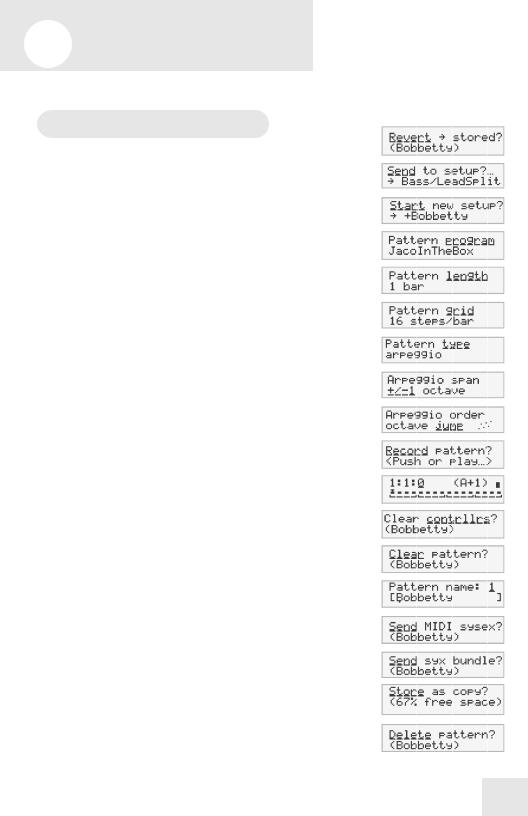
3 Patterns
Playing Patterns
Pattern options:
Patterns are repeated melodic figures that you trigger from the keyboard.
Press [patterns] near the control knob. To cycle through different patterns, turn the control knob. The pattern will change, with the current pattern name shown in the display.
The pattern continues playing as long as you hold down the key.
Using [latch]
Press [latch] to keep the tempo steady as you shift between notes.
Press [latch] again to stop the pattern from playing.
Using [tap]
Tap the [tap] button to increase or decrease the speed of the pattern. To adjust the tempo with finer control, hold down [tap] and turn the control knob. The display will indicate the precise tempo.
19

3 Patterns
Pattern Types: Arpeggios and
Sequences
A pattern can be set to one of two types: “arpeggio” or “sequence”.
Arpeggios and sequences both respond to a keypress by playing a series of notes over a programmed rhythmic pattern. The difference lies in which notes they play.
An arpeggio loops over whatever notes you are holding down on the keyboard. If you hold down a chord, the Micron will generate a melody by playing each note of your chord individually.
A sequence, on the other hand, already has a melody line built in. So, all you have to do is hold down a single key, and the Micron will play back that melody relative to that key. Pressing another key will transpose the sequence.
A pattern can easily be switched from an arpeggio to a sequence, and vice-versa. The underlying rhythmic pattern is kept the same - - all that changes is whether the pattern plays the notes you hold down or the notes it was recorded with.
If the distinction is unclear, choose your favorite pattern, toggle its “type” parameter between “arpeggio” and “sequence” (see page 24), and try playing it both ways.
Phrases versus Patterns
In Programs and Setups modes, the Phrase button lets you quickly record and repeat a riff or melody line. Phrases are designed to be used “live”, when inspiration strikes as you're playing.
A phrase is nothing more than a pattern that was recorded using the Phrase button. In fact, the most recently recorded phrase is stored as a pattern named “* Phrase”. If you happen to record a phrase that you really like and want to hang on to, simply find the “* Phrase” pattern and give it a new name.
20

3 Patterns
Editing Patterns
Choose an existing pattern to edit by pressing the [patterns] button and turning the control knob. Hold down any key to play the pattern. (Use the [tap] button to change the tempo.)
Once you’ve found a pattern you want to edit, press the control knob to enter edit mode. Turn the control knob to cycle through the different options. Press the control knob to toggle in and out of editing the current parameter.
Here are the pattern editing options:
1. Revert-to-stored? / Unrevert-to-edited?
If you have edited a pattern, you may revert back to the original version. Press the control knob to revert.
Go back to your edited state by press the control knob a second time to unrevert.
Use revert and unrevert often in order to compare your changes to the original pattern. When you’re satisfied with your work, press [store] to save your changes.
Store your pattern
The [store] button will light once you have edited a pattern.
Press [store] after you’re satisfied with your edits. Otherwise, your changes will be lost when you turn off your Micron.
21

3 Patterns
2. Send to setup?
Pressing the control knob at this option sends you to [setups] mode and allows you to make this pattern a part of the lastselected setup.
If the setup does not have any parts, this pattern is automatically assigned to the setup’s part A.
If the setup already has one or more parts, you will be able to add the pattern in one of the following ways:
1.send to part. The setup's part will use this pattern. Remember that a part uses both a program and a pattern. If the part's program is set to “(pattern's pgm)”, then the pattern will sound just as it does in Patterns mode. Otherwise, the setup will play the pattern using the part's own program.
2.layer. The setup's existing part is duplicated, resulting in a new part. The pattern is then sent to the new part.
3.split low. The setup’s existing part is split in two at a particular key.
The Micron prompts for a note on the keyboard at which to execute the split. The pattern is then sent to the lower part of the split. Every note below the one you select will use this new pattern. Every note including and higher than the note you select will use the setup’s existing part.
The new part is assigned the next letter after the split part. For example, if the setup contains parts A, B, C, and D, and part B is the part that gets split, then part C will be the newly-added part. All later parts’ letters are incremented by one.
To select the split point, turn the control knob or play a key. You can use the [octave] buttons if your desired split point is outside of the current key range.
4. split high. The setup’s existing part is split in two at a particular key.
As with the split low option, the Micron prompts for a note on the keyboard at which to execute the split. The pattern is then sent to the upper part of the split. Every note above the one you select will use this new pattern. Every note including and lower than the note you select will use the setup’s existing part.
Send to setup only allows the option of sending the pattern to the current setup.
Therefore, you may need to jump out of pattern editing to choose a setup before returning to patterns and following this procedure.
How part letters change when “layer,” “split low,” and “split high” are used
When parts are layered or split high, the new part is assigned the next letter after the targeted part. All subsequent part letters are incremented by one.
For example, consider a setup with four existent parts:
A
B
C
D
If we split part B, the result is as follows:
A
B (low split of B) C (high split of B) D (formerly “C”) E (formerly “D”)
22

3
To select the split point, turn the control knob or play a key. You can use the [octave] buttons if your desired split point is outside of the current key range.
5. add part. The pattern is added as a brand new part. All other part parameters are set to their default values.
3. Start new setup?
Pressing the control knob at this option creates a new setup named with the pattern’s name and a “+” in front (e.g. “+Liner” and “+Bobbetty”) and, if a setup with this name already exists, a number at the end (e.g. “+Liner2” and “+Bobbetty2”).
4. Pattern program
Choose the program that the pattern will use to play its notes. In order to quickly jump between program categories, you can hold down the [patterns] button and press the white keys labeled with category names.
Another way of setting the pattern’s program is to bring it over from Programs mode. Press [programs] to enter Programs mode, and find the program that you want. Then, hold down [programs] and press [patterns], and the pattern’s program will be set. This works in the other direction as well -- hold down [patterns] and press [programs] to bring the pattern’s program over to Programs mode, perhaps for some quick editing.
5. Length
Select one of 1/4, 1/2, 1, 2 or 4 bars.
The pattern will always play from the first note of the first bar. So, if you select a value shorter than the current one, the latter parts of the pattern will be truncated. If you select a value longer than the current one and the latter part of the pattern does not contain any notes, the new notes at the end of the pattern will be empty.
Patterns
Length and Grid quantizing
The Micron records your playing at a very high resolution. The length and grid settings that you select for playing back your patterns are used to nondestructively quantize those recordings.
So, if you record a four-bar pattern and change its length later to ¼ bar, the Micron will only play a fraction of your pattern, but it will remember the whole thing. If you want to change the length back to four bars at any time, the complete pattern will still be available.
Similarly, pattern rhythms are quantized using the grid setting, but the underlying information remains untouched. So, as you cycle through different grid settings, you’re likely to hear different syncopations and “feels” emerge.
23

3 Patterns
6. Grid
Choose 8, 12, 14, 16, 20, 24, or 32 steps per bar, or choose unquantized. Shortening the scale decreases the quantizing resolution. You’re more likely to hear double notes and simpler syncopations at low values.
Straight-ahead feels tend to result from using 8, 16, and 32 steps per bar. Swing and shuffle feels tend to result from choosing 12 or 24 steps per bar. But you can create some pretty wild patterns by using fractions of bars along with less obvious grid values, like 14 and 20.
7. Type
Choose sequence or arpeggio.
8. Span (arpeggios only)
Choose a span ranging from single note – in which the note you press on the keyboard will be the only note that plays – to one that plays up, down, or up-and-down through 1, 2, 3, or 4 octaves.
9. Order (arpeggios only)
When you hold down more than one note, you can specify the order in which they will be arpeggiated:
●The order in which they were initially pressed (called as played).
●Up. The arpeggiator plays the notes you are holding from the bottom to the top. Once the top note is reached, the arpeggio begins from the bottom again.
●Down. The arpeggiator plays the notes you are holding from the top to the bottom. Once the bottom note is reached, the arpeggio begins from the top again.
●Up+Down Incl. This mixes the up and down settings, playing up the notes you are holding and repeating the top note and the bottom note. The incl stands for inclusive.
●Up+Down Excl. This mixes the up and down settings, playing up the notes you are holding without repeating the top note and the bottom note. The excl stands for exclusive.
●Octave Jump. The arpeggiator plays the notes you are holding but plays the first note in two or more octave registers before playing the second note, which it also plays in two or more octave registers, etc.
Four Beats per Bar
All Micron patterns have four beats per bar.
You can still create oddmeter rhythms. It just takes a little calculation and a willingness to ignore the tempo indications given by the [tap] button.
For instance, one way to create a ¾ feel is to combine a length of ½ bar with a grid of 24 steps. That will give you a total of 12 steps to work with.
Ignore the display’s “6 + 6” grouping. Think “4 + 4 + 4” instead.
Arpeggios or Sequences? Arpeggios contain rhythm and velocity (relative volume) information.
Sequences contain not only rhythm and velocity information but also pitch information.
Use arpeggios for computergenerated patterns.
Use sequences for melodies and basslines.
Octave Jump
To hear Octave Jump in action, Span should not be set to “single note.”
24

3
10. Real-time recording
Once you've reached the “record” parameter, you'll hear the metronome start to click. Use this "lead-in" time to get yourself into the groove. (As always, if the tempo isn't right, you can use the [tap] button to adjust it.)
Once you're ready to play, just start playing. The Micron will begin recording from the first note of the pattern. Alternately, if you don't want to play from the first note, you can push the control knob to kick off the recording.
The pattern will loop continuously, so you can add to it each time it comes around. When recording in real-time, remember that playing will never erase anything you've already recorded. To wipe out a section so you can replay it, hold down the control knob as it gets played back.
To stop recording, turn the control knob or press a mode button.
You will often want to clear the entire pattern and start over. One way of doing this is to hold down the control knob and wipe out the pattern as you record. But a quicker way is to hold down the [patterns] button and hit the highest note on the keyboard. This is a shortcut to the “Clear pattern?” option. See page 27.
The Micron records not only the keys you play, but all movements of the sliders, pitch wheel, and knobs. These controller movements don't even need to be recorded at the same time as the keys. A useful technique is to play the keys first, and then when the recording loops around, play on the controllers to add some life to your notes. If you do this, you will probably also be using the “Clear controllers?” option as well, so you can revise your controller movements until you're satisfied. See page 27.
Patterns
Time display
The Micron displays time as “bar:beat:tick”. There are four beats in a bar, and 120 ticks in a beat.
Three-step beats land on 0, 40, and 80.
Four-step beats land on 0, 30, 60, and 90.
Five-step beats land on 0, 24, 48, 72, and 96.
Changing the metronome
The metronome you hear when recording is, in fact, just another pattern. It is named “* Metronome”, and appears near the beginning of the pattern list. You are free to edit this pattern all you like. For example, you can choose a different program, or put the clicks on eighth notes or triplets instead of quarter notes. A quick way of disabling the metronome entirely is to simply rename this pattern and store it. You can always bring back the metronome later with another rename.
25
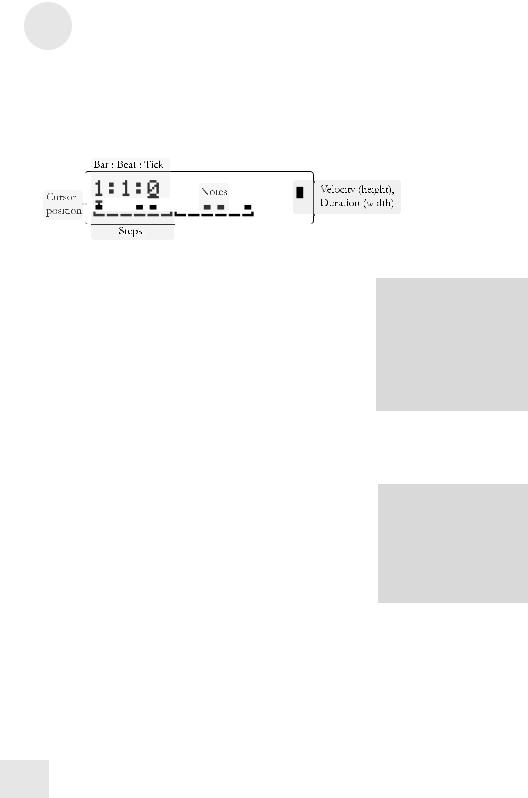
3 Patterns
11. Step editing
Turn the control knob to cycle through each step. You can quickly jump to the first step of the pattern by holding down the [patterns] button and pressing A above middle C (labeled “osc”).
Every aspect of the pattern is editable:
a. Adding and replacing notes and chords
Play one or more keys at any step to add (or replace) that step’s entry. Pitch, velocity, and length will be recorded, as will any controller and knob moves you make while the keys are held down.
If the pattern type is set to “arpeggio”, the pitch will not actually be used when the pattern is played back, since the Micron will play the pattern over whatever notes you hold down. But if you later set the type to “sequence”, your recorded pitches will reappear.
The cursor will automatically move on to the next step.
b. Removing notes
To remove a note, place the cursor under any step and double-click the control knob. The note, plus all controller movements between this note and the next one, will be removed.
c. Moving notes
To move a note, place the cursor under it. Then press and hold down the control knob and turn it to the left or right. Imagine that you are “dragging” the note.
Controllers and step editing
Remember that controller movements are recorded while a note is held down.
So, it is perfectly possible to record a pitch bend while step editing; just play the note and turn the pitch wheel.
Removing multiple notes
To remove multiple notes at once, place the cursor at the right-most note you want to remove. Then press down on the control knob and turn it all the way to the left before releasing it.
26

3
d. Editing velocity
Place the cursor under the note that you want to edit and press the control knob. Turn the control knob to increase or decrease the velocity.
You can remove the note by turning the velocity down to zero.
While you're editing velocity, you can play any key to hear what the note sounds like at that velocity.
Note: Though the duration of the note is displayed in this screen, it cannot be edited here.
e. Editing duration.
To edit the duration of a note, move the cursor to it and play the note with the duration you desire.
The duration value cannot be edited directly, but a rough indication of the duration can be seen on the upper right side of the display.
12. Clear controllers?
Press the control knob to erase all slider, pitch wheel, and knob movements from the pattern, but keep the notes. This is handy if you recorded some controller movements that you're unhappy with, and want to try another take without starting the pattern from scratch.
13. Clear pattern?
Press the control knob to erase all notes and controller movements from the pattern, but keep the basic pattern parameters. To quickly jump to this option, hold down the [patterns] button and press the highest note on the keyboard.
Patterns
Gauging note velocity and duration on the display
As you place the cursor under each note, the top right side of the display will change.
Higher velocities are illustrated with higher bars.
Longer note lengths are illustrated with thicker bars. Notes can overlap one another, but that overlap is not visible on the display.
27
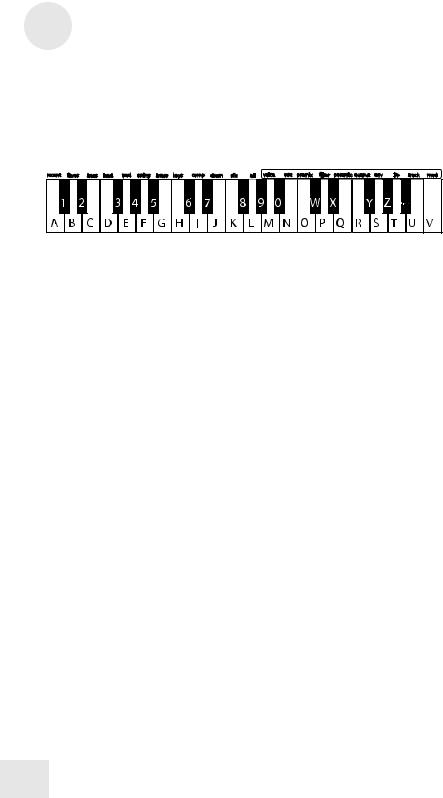
3 Patterns
14. Pattern name
Since patterns are listed alphabetically, creative naming can help you move smoothly from one pattern to another.
Turn the control knob to select a position (1 – 14) to edit. Then press the control knob to edit that position. Edit either by turning the control knob or pressing notes on the keyboard.
Press a key twice to toggle between upper and lower case.
Inserting and deleting characters
To insert a space in the name, navigate to the position at which you want to add the space. Hold down the control knob and turn it clockwise.
To delete a character, navigate past it, hold down the control knob, and turn it counterclockwise.
In both cases, imagine that you are “dragging” the name around.
15. Send MIDI sysex?
Choose this option to send the pattern to a computer or other MIDI storage device using the Micron’s (MIDI OUT) port.
This allows you to back up your patterns to your computer, or share them with your friends or over the internet. See page 95 for details on what Sysex is and how to use it.
16. Send syx bundle?
Choose this option to send both the pattern and its program to a computer or other MIDI storage device using the Micron’s (MIDI OUT) port.
17. Delete pattern?
Delete the pattern using this function, if desired. You will be prompted to confirm this action.
28
